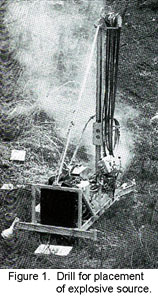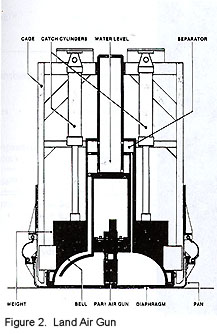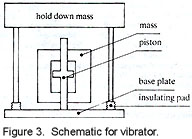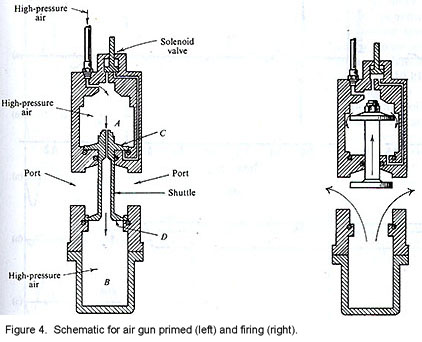We hope everybody enjoys our insight into the exciting world of seismology.
If you have comments or suggestions, e-mail me at ezimmer@tiger.lsu.edu.
| A seismic source is defined as any device which releases energy into
the earth in the form of seismic waves (Sheriff, 1991). There are two main
groups of seismic sources: land seismic sources and marine seismic sources.
Land seismic sources are used on land because the characteristics of the
seismic waves they generate best suit the needs for seismic exploration
in a terrestrial environment. Likewise marine seismic sources are used
in water because their characteristics are best suited for exploration
in a marine environment. |
| Seismic sources are crucial to the field of reflection seismology.
The goal of reflection seismology is to locate mineral deposits, archaeological
sites, as well as gather geological information for engineering purposes
through the use of artificially generated seismic waves. These waves are
generated and then recorded at detecting stations. The records are then
used to record the subterranean geology of the area (e.g. existence of
hydrocarbon deposits, etc.). Seismic sources are vital to the field because
they generate the very seismic waves which provide the data for subterranean
geology. |
| For land seismic sources, it is desirable to generate a
highly energetic wave of short duration that is repeatable and does not
generate noise that interferes with detection. Impulsive sources are the
most commonly used sources. The most common type of impulsive source is
a subterranean explosive source (dynamite). Typically an explosive source
is used in the following manner: a hole (usually between 6-30 m) is drilled
at the desired location; the charge is placed in the hole with a loading
pole (to insure it achieves the proper position); and the charge is detonated
with an electrically ignited blasting cap. The frequency of waves from
small charges is higher than that of large charges and the depth of the
charge affects noise generation. Standard charges expend their energy in
all direction. A special type of explosive charge is used when a focused
charge direction is desired. |
|
 |
|
| Explosive charges are more effective when used in a waterless area
or an area below the water table. Also, porous or low density mediums hamper
the effectiveness of explosive sources. Furthermore, the boreholes are
often fractured with the first detonation, requiring corrections for data
in subsequent charges. In addition to subterranean sources, a variety of
surface sources are used in reflection seismology. The impulse generated
by these devices occurs at the surface of the earth rather than beneath
it. Air shooting is another seismic impulse generating technique. Explosive
charges are also used in air shooting but rather than being placed in boreholes
they are placed atop an array of sticks and detonated above the ground.
The expanding air wave created by the explosions creates the impulse as
it strikes the ground. |
| Weight droppers also generate impulses. The operation of a weight dropper
consists simply of a dropping a 3 ton weight from a 3 m height, and recording
the impulses. The impulse generated is not particularly strong and weight
droppers are generally only good in deserts, where the waterless conditions
are best suited for this technique. |
| Another type of impulsive land seismic source is the land
air gun. This device consists of a water pan with an expandable diapragm
and an air gun. This device is placed beneath a vehicle and is held against
the ground by the vehicle's weight. The gun fires compressed air into the
water pan, forcing the pan's diaphragm into the ground, creating an impulse
which is transmitted into the earth.
In general, surface sources are not usually practical, as they generate
a weak impulse. In addition, the impulses must travel through the soil
layer, an area of low seismic velocity. The characteristics of the surface
also affects the behavior of the impulses. |
 |
Nonimpulsive sources differ from impulsive sources in that they transmit
energy in the ground for an extended period of time. The most common type
of nonimpulsive source is a vibrator. A vibrator is composed of a base
plate connected to a piston inside a large mass. Oil is either pumped in
or out of the piston chamber, causing the mass to oscillate. The oscillations
are transmitted through the plate into the ground. Vibrators are generally
mounted on large trucks which move together over the prescribed area.
| Vibrators are useful in cities and other easily-damaged
areas due to their low energy density. However, the equipment is extremely
heavy and as a result is sometimes not allowed in the very areas where
a low-energy source is desirable. |
 |
| Another non-impulsive source is the Sozie, or the "whacker". In the
Sozie method, an impactor strikes the ground 5-10 times/sec for about three
minutes and the results are recorded on detectors. |
| The primary consideration in deciding which type of land seismic source
to use is economic. The least expensive method is generally the most often
used. However, other factors must sometimes outweigh those of cost. Transport
considerations must also be taken into account. Surface source equipment
is often very heavy, requiring very large transport vehicles. Generally
subterranean explosive sources are preferred, but they are sometimes impractical
because the exploration area is difficult to drill or has restrictions
against drilling. |
| Marine seismic exploration is more expensive and more involved than
land seismic exploration. Marine sources require a ship to transport them.
Generally marine seismic exploration is more long term than land seismic
exploration's operations generally lasting between 1-2 months. |
| An ideal marine seismic source should generate a high peak pressure
and low secondary operations. Originally submerged explosive sources were
used in marine seismic exploration. However, they are rarely used today
because their results are seldom those of an ideal marine source. It was
soon discovered that they were not very practical because the gases produced
by the explosions oscillated in the water, creating waves which interfered
with the intitial impulse, making interpretation impossible,. This was
termed the Bubble Effect. The situation was rectified by using aerial explosive
sources but safety considerations hampered this method. |
| The most commonly used marine seismic source is the air
gun. This gun injects high-pressure air into the water. The air guns consists
of two chambers and a piston-like apparatus called the shuttle. Air moves
from one chamber to the other through the shuttle. Eventually, the pressure
forces the shuttle upward, releasing air into the water through vents.
As with explosive sources, the bubble effect creates oscillations, but
due to the small energy release, the bubble effect lengthens the initial
pulse instead of creating conflicting pulses. Air guns are generally used
in arrays. |
 |
One way of disregarding the bubble effect is by using the device of
imploders, that is, a device which generates a void in the water, into
which water rushes in, generating waves. Some types of imploders are the
Hydrosein, in which two plates are shoved apart by air-piston, creating
a void space, and a Boomer, in which a plate containing meta coilreceives
an electric current, forcing two plates apart.
The water gun works on the same principle as the air gun, but water
is forced out rather than air. The expelled water creates a vacuum in its
wake, resulting in an implosion.
Several other types of marine sources have been invented to combat the
bubble effect. Sparkers send an electric spark between two electrodes,
vaporizing the surrounding water and simulating an explosion. Less often
used are the Aquapulse, a submerged explosive source in which the waste
gas is ejected into the atmosphere; the Vaporchoc, which fires a bubble
of superheated steam into the surface; and the Flexotir, which detonates
a charge in a porous steel cage thus dampening bubble oscillations.
LINKS OF INTEREST



